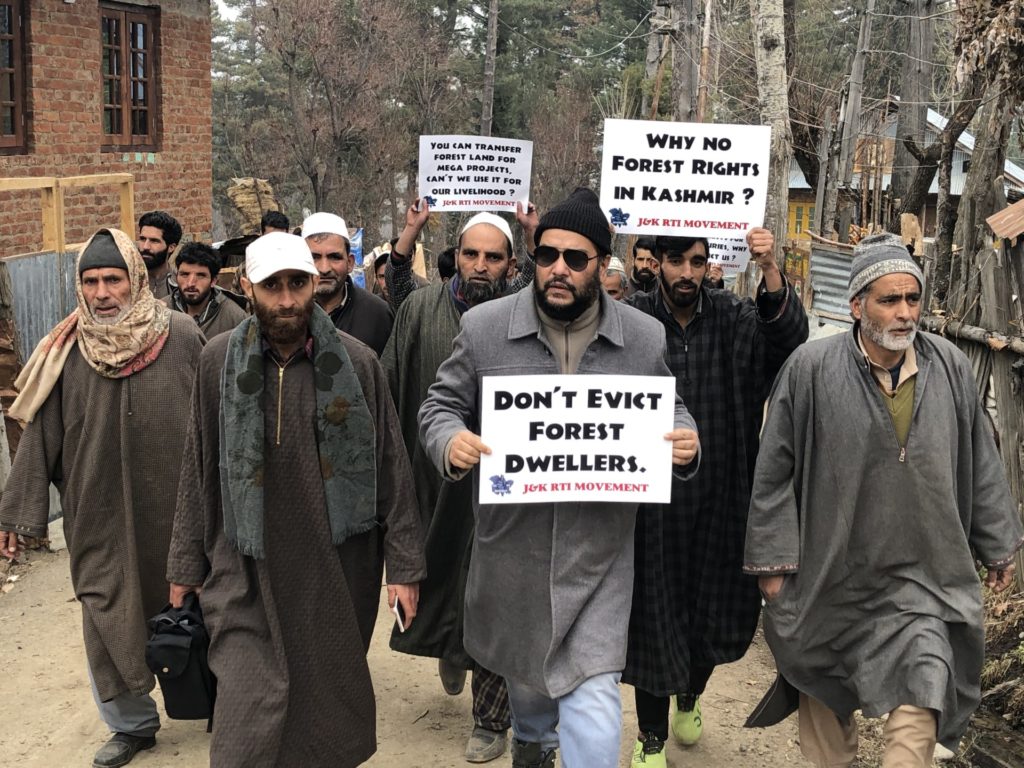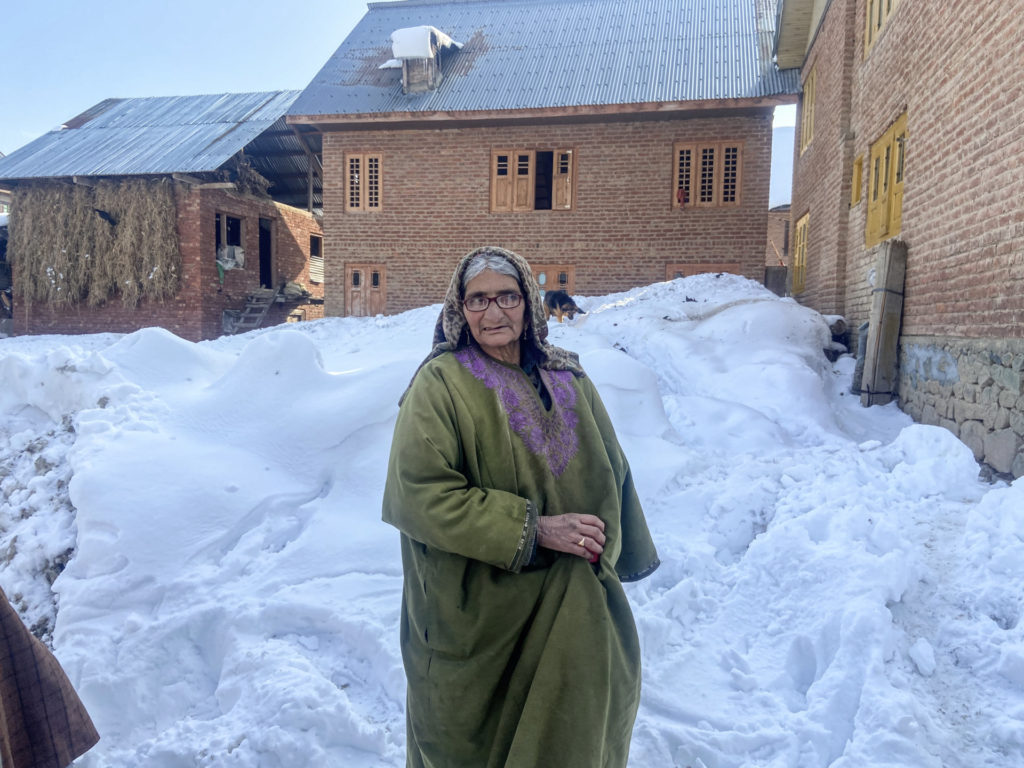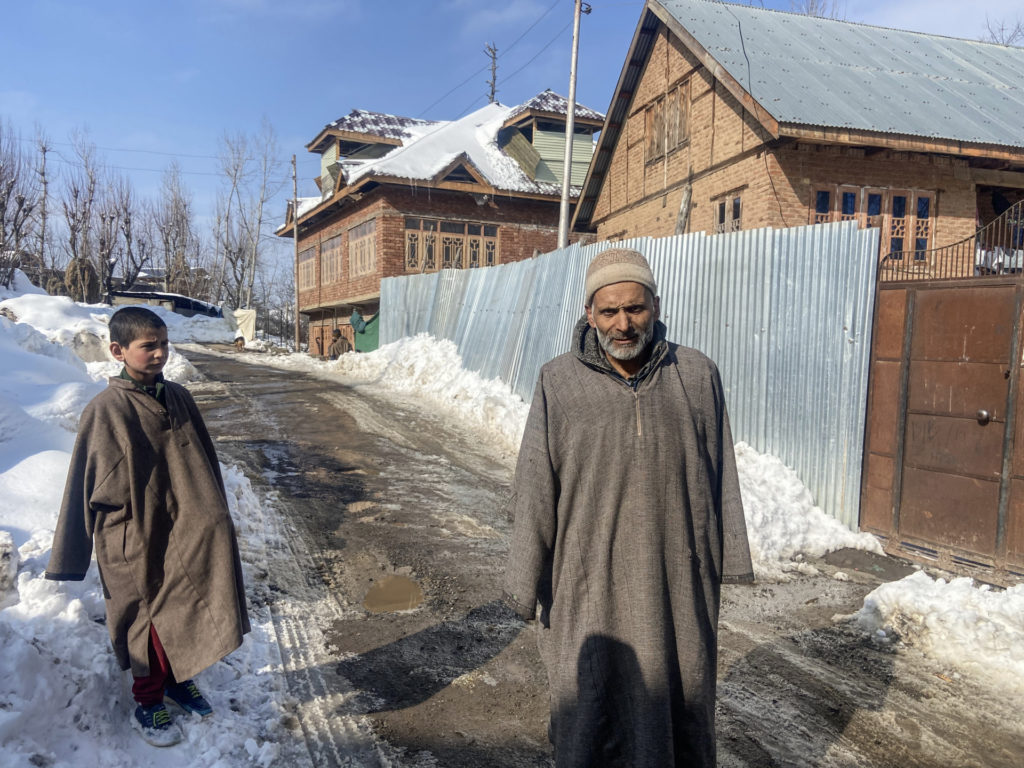Fayaz Ahmad is angry. His only source of income was destroyed when the Jammu and Kashmir Forest Department cut down tens of thousands of apple trees, including his own. The ordeal unfolded one night during the last week of November 2020 and has since left the 57-year-old patriarch unable to provide for his family of 10. His orchard, which had 150 apple trees — all axed — had been passed down to him by his father.
“My father would narrate to me stories of how our family worked day and night to turn this barren piece of land into an orchard. And ever since I have taken over, I have been doing the same no matter the weather. I can say that these trees and I have grown up together,” he said, amid a group of people gathered in the village during an interview with Newlines.
In Kanidajan, the villagers have been in a state of mourning since that awful day, when forest officials also demolished nomadic huts (dokhas), leaving families homeless in subzero temperatures. Similar drives happened in other areas, including Nagbal, Yusmarg, Darwan, Jabad Branwar, Raiyar, and Arizal in the southern Kashmiri district of Anantnag.
Kanidajan, located some 40 kilometers (25 miles) from the summer capital of Srinagar in the disputed Jammu and Kashmir region, has a population of 5,000 distributed among its 400 houses. A hilly, snowcapped terrain leads to the village, which has witnessed one of the harshest winters in the Kashmir Valley in over three decades. This, perhaps, is how the Forest Department managed to cut so many trees before anyone could protest: People had been braving subzero temperatures inside their homes, unaware of what was unfolding outside. But after the ordeal, angry locals and activists have become energized to seek justice for what they say was a sneaky and illegal act done in bad faith by the Indian-administered authorities, which many accuse of engineering a demographic change in Muslim-inhabited areas of Kashmir.
Apple produce is one of the major parts of Jammu and Kashmir’s agricultural economy, but over the last few years the industry has been in decline. On Aug. 5, 2019, when New Delhi unilaterally revoked the region’s semi-autonomous status, the entire valley remained under a military and communication lockdown for almost a year, which led to devastating repercussions on all sectors in Kashmir.
Ahmad recalls how he, too, faced the financial crunch in 2019. But now with the trees gone, including some that were nearly 100 years old and planted by his grandfather, he has lost about $27,000.
He questions the claims of the government, led by Prime Minister Narendra Modi, that they are bringing “development” to the Himalayan region after revoking autonomy. “The irony is that Modi claims to empower the people of Kashmir, but by this inhumane act they have proven that their actual mission is to make people of Kashmir economically weaker,” he said.
Politicians and activists in the region consider these acts to be part of the government’s project, led by the Hindu-nationalist Bharatiya Janata Party, to dispossess people of their land and property in order to change the demographic status of the Muslim-majority region.
The activists say the way authorities are sending eviction notices selectively to the people of the tribal community could mean thousands of people will be rendered homeless in the near future.
As for the orchards, Ahmad says he would have given his life to save them. But it was all done very quietly.
“We would have opposed the brutal act, but there was a rumor that the army had cordoned off the orchards, and in Kashmir no one wants to mess with the Indian army. We learned later that there were about a hundred employees of the Forest Department who were wearing the same uniform as the army’s,” he said.

After the removal of autonomy, and since New Delhi has direct control over the administration in Jammu and Kashmir, the authorities have ratified laws that allow Indian nationals to buy land in the disputed territory. In the most recent moves, Kashmir’s nomad groups, the Bakarwals and Gujjars, have been facing eviction notices from their forest dwellings. The tribal groups move from meadows to plains according to the weather conditions and settle in forests in the summertime to feed their cattle. Kashmir has at least 1 million Gujjars, according to the census, and the indigenous groups are spread over various meadows and plains across Jammu and Kashmir.
The move by the government has been called out by the unionist political parties and politicians, including former chief ministers of Jammu and Kashmir Omar Abdullah and Mehbooba Mufti.
“The Gujjars use log and mud sheds in pasture lands during the grazing season. They are part of the forest and our environment. Sadly, a drive has been launched to demolish these structures, which they use as temporary shelters during the summer,” Mufti said during a small gathering of nomads after a video showing the demolition of a hutment went viral.
The former chief minister said that the administration had already “given away 24,000 kanals (2,965 acres) of land” to the industries and asked the administration to come clean on the beneficiaries.
Seventy-year-old Shareef Ud Din Bajad from Kanidajan is from a nomad tribe. He says that he and his family have been traumatized since their orchid of 50 trees was chopped down.
“My daughter asks me every night if they (officials) will come back to destroy our home like they destroyed our tree.” Bajad told Newlines. “What have they gained by chopping our trees? I believe they want us to die of starvation as they axed the only source of income to feed my family.”
While apple trees were being cut down in central Kashmir, Gujjar nomads who dwell in the south were given eviction notices to vacate the land. The nomads live in temporary, makeshift huts made of mud and wooden logs. Zahir Khatana, a Gujjar, lived in a similar hut in Kashmir’s exotic tourist location, Pahalgam, nearly 100 kilometers (62 miles) from Srinagar. Pahalgam, owing to its substantial, lush meadows, is home to thousands of nomad families every summer, before those families migrate to hotter regions in the state for winter. In November 2020, thousands of such families in Pahalgam were given eviction notices by officials from the Forest Department.
There are reports that at least three of those houses were also demolished by the officials. Mufti said the objective of the government’s move to demolish the hutment was “to dispossess” Kashmiris.
Activists are looking at the move as a larger part of the “land grab” that New Delhi has been accused of by many in Kashmir since Aug. 5, 2019.
Prominent rights activist Raja Muzaffar Bhat has been passionately seeking justice for marginalized people since he was young. He argues that the people facing eviction notices have a legal right to the land.


“The people in the forest region were given forest land (without trees) under the official program to grow more food, but unfortunately the proper paperwork was not done from the administration side,” Bhat said.
Bhat says that the Jammu and Kashmir reorganization bill, which came into effect after the abrogation of Article 370, mentions that all the previous and existing policies and programs will remain intact. Article 370 exempted the state of Jammu and Kashmir from the Indian Constitution and permitted the state to draft its own constitution. But New Delhi scrapped this semi-autonomous status, thereby implementing and introducing new laws. “So it can be challenged in court, and we can ask on what behalf they (authorities) axed the trees and evicted the nomads,” Bhat said. “These people got the legal right over their land during the tenure of Sheikh Mohammad Abdullah when he introduced (the) land reforms act.”
Abdullah played a central role in the politics of Jammu and Kashmir and was the first elected Prime Minister of Jammu and Kashmir after its accession to India. Abdullah has been praised for the land reforms he introduced, which most Kashmiris identify through the slogan, “land to the tiller,” since he promised that the people from the landless community would be provided land.
The forest land was categorized into two segments: those with trees and those without. In order for people to increase food production, Sheikh Abdullah decided to give the land that was without trees to people who lived near the forest, but a paper record for the land transfer was not maintained by the government at that time.
The nomads also have a claim to the land in accordance with the Forest Rights Act, 2006, which gives rights to forest dwellers across India. As per the act, the members of the Scheduled Tribes dwelling in the forests, along with other traditional residents, have the right over forest land for habitation or self-cultivation and livelihood. The Forest Rights Act allows the use of up to 1 hectare (2.5 acres) of forest land for developing government facilities, including schools, minor water bodies, and hospitals.
Bhat is adamant to take the fight against the state. “We will fight through legal means until justice is delivered to us. India claims to be the world’s largest democracy; this will be the reality check for their claim. Even if justice is delivered, it will take a minimum 12 years to have an apple orchard again, which is also not possible without any financial aid.”
Asim Wagay, also from Kanidajan, has come to Bhat after the authorities cut down 110 trees from his orchard. Wagay says his great-grandfather was an occupant of that land and that it has been in the family’s possession for more than 100 years. According to the Forest Rights Act, one must hold a piece of land for 75 years in order to have a right to use it for agriculture.
Bhat says there is no basis for the government to harass the nomad people. “I believe the government is trying to create a land bank as the Jammu and Kashmir government has identified 200 kanals, or 25 acres, (of) land in Budgam district to set up Kashmir’s first Sainik colony,” he said.
He also questions the law under which the authorities issued the eviction notices. “The notices were issued under the Indian Forest Act of 1927, which is an obsolete law. Unfortunately, it was based on this obsolete law that the administration axed more than 10,000 apple trees in one village alone and demolished several mud houses (kothas) of nomadic families,” Bhat added.
Before the abrogation of Article 370 in 2019, the government claimed that the semi-autonomous status of the disputed region had been a barrier to the implementation of laws, including the Forest Rights Act in the region. However, the residents now question the intention of the government and say that the people have been misled.
The villagers claim their forefathers have been the caretakers of this land for generations. Zoon Bano, 95, wears a traditional pheran and holds her kangri (an earthenware pot used to warm oneself) when she meets journalists who visit her village. She tells her story over and over in the hopes that someone will hear her plight. Bano says her grandfather used to cultivate potatoes and corn on their land, and later her father planted the apple trees that were chopped down by the officials. Bano walked up to the spot and pointed toward the land. “They cut my limbs, not trees,” she said, her voice husky.


The authorities cut the trees when people were least likely to take notice. It happened when most of those regions were partially cut off due to heavy snowfall. “These are all forest regions where heavy snowfall occurs, and people were not able to attend any meetings or even oppose any actions. The officials conducted closed-door meetings instead of a village gathering to implement any new law. These meetings could have waited till the weather would have improved, but it was completely an undemocratic process with no role for women at all,” Bhat explained from his office in Srinagar.
Another villager, Abdul Majeed Wagay, 44, says his family has been living in the forest area for generations. “No government ever harmed us. In fact, they provided us with trees for planting. I didn’t receive any notice from the administration about any illegally occupied land. Weren’t they supposed to inform me that they will axe my trees? At least I could have uprooted the small trees. I just want compensation for all the loss, or my family will die of poverty,” he said.
The discourse in Kashmir since August 2019 has changed, and Kashmiris have become vocal in calling out what appears to be India’s intention for “demographic change.”
“Since the abrogation of Article 370, there is a complete anarchy. Be it police, army or administration, no one can be held accountable for their acts. There is a big conspiracy underway, and they want land for military establishment or for settlement of non-Kashmir people. So be it demolition of nomad huts or eviction notices or uprooting trees, it all comes down to one point — taking our land for the settlement of non-Kashmiris,” said Ayesha Mushtaq, a student of law from University of Kashmir.
Kashmir-based human rights activist Khurram Parvez said in a tweet that the motive of the government was “land grab and demographic changes.”
“It cannot be any more brazen and violent as all these laws are being introduced amid a pandemic,” Parvez said.
Dr. Sheikh Showkat, a human rights activist and political analyst based in Kashmir, said that under the Treaty of Amritsar signed in March 1864, the maharaja of Kashmir purchased the whole of the state so the majority of the land belonged to him. Only a small percentage of the land had ownership rights to those who held it, and that land was mostly within the old city and some villages. “The rest of the land was occupied by the people of Kashmir as tenants. Now the present government has overturned the two legislations that confirmed title to the people. One (piece) of the legislation being the Big Landed Estate Abolition Act, and the other was the Agrarian Reforms Act. These two legislations are known as ‘land to tillers,’ and they gave ownership rights to the people.”
Dr Showkat said that in Kashmir, a large chunk of land belongs to the government, but people have been using it for agriculture for generations — over 200 years. “Now, suddenly the administration is claiming the land is (government land), be it forest or another type of land. By doing so, they want to create a land bank that could be used for settlements.”
He said the government was targeting the tribal population who were primarily restricted to forests, along with their cattle. But the real intention is to find any land and vacate it for new settlements.
“The same can happen within the cities and villages wherever they (the administration) find land. They will remove the persons … in the name of (accumulating the) land bank, which they claim to be used for industrialization,” he said. “But their actual motive is settlement of outsiders as there is no legal barrier for an outsider to purchase land within Jammu and Kashmir,” he added.
Responding to claims of land appropriation with the intention to change the demographics, Kashmiri authorities have issued repeated denials. The Jammu and Kashmir Lt. Gov. Manoj Sinha asserts in the local press: “No outsiders will come on those lands.”
“The industrial areas that we have defined, we want that like the rest of the country,” he is quoted as saying, adding that he aims to create new jobs.
Speaking on condition of anonymity, one local official told Newlines that the authorities who axed the apple orchards in the middle of a frosty night were “simply following orders.”




